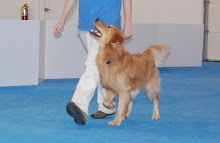Day one was powerpoint and discussion with a few short demos and video. Day two was all about working dogs and considering our new knowledge while watching the teams work.
Day one:
Scientific Perspective:
Discussion about science, scientific thinking, and the approaches used in different areas of science. This became quite a point to come back to all weekend. Most of the attendees were dog professionals or dog enthusiasts.... and all/most familiar with an approach to science and thinking about dogs from a psychology viewpoint. Fox was very much using the ethology vocabulary and giving us that perspective. This was challenging for many of us, but definitely makes it easier to think about "behavior as behavior" than to be (on the verge of ) anthropomorphic. I'd thought I was fairly good at looking at behaviors but I definitely have room for improvement.
The conflict for me will be that the more psychology-language can help clients be more empathetic to their dogs. On the other hand... we do want them to see that dogs are completely different in how they view the world and sometimes we need to help remind clients of that difference.
Some examples of the vocabulary: If we say a dog is afraid/fearful/shy, we aren't describing specific behaviors, we are describing groups of behaviors in a shorthand that is helpful when speaking to someone else dog-savvy, but not so helpful when it comes from a client's mouth. We could say specifically, "He moves away, he moves slowly, his tail is tucked." Or we wanted to group the behaviors under one term, we could say the dog is showing "avoidance". "Avoidance" helps us know what is happening in general, without the emotion and to not use a word that will prompt additional connotations or as much emotional response from the human. Another example: Distractions. That's a normal piece of dog training vocabulary. We know what it means. Something that's interesting in a problematic way. "Attractive stimuli" is another way to think of it. We're not saying it's good or bad. We're just saying it's there, something perceived in the environment, and the animal is interested.
Flight Zones:
 |
| A group of cattle watching the dogs. The cows are about 150' away. Cows tend to have one or two adults supervising a larger group of young. |
Overall....the weekend gave me a lot to think about. It's kind of like operant conditioning...once you understand and think about it, you know that's impacting learning all the time, whether or not you want it to, whether or not you're thinking about it. This weekend opened up another similar concept. There are always things changing in the environment. These changes are always impacting behavior.
Taking it to a smaller level....next up will be about motor neurons.




No comments:
Post a Comment